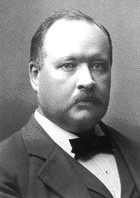Svante August Arrhenius (1859–1927)
 Svante
August Arrhenius was born on February 19, 1859. His father was a land surveyor
employed by the University of Uppsala and in charge of its estates at Vik, where
Svante was born. The family moved to Uppsala in 1860. From an early age Svante
had shown an aptitude for arithmetical calculations, and at school he was greatly
interested in mathematics and physics. In 1876 he entered the University of
Uppsala, studying mathematics, chemistry and physics. The practical instruction
in physics was not of the best, and in 1881 he went to Stockholm to work under
Professor E. Edlund at the Academy of Sciences.
Svante
August Arrhenius was born on February 19, 1859. His father was a land surveyor
employed by the University of Uppsala and in charge of its estates at Vik, where
Svante was born. The family moved to Uppsala in 1860. From an early age Svante
had shown an aptitude for arithmetical calculations, and at school he was greatly
interested in mathematics and physics. In 1876 he entered the University of
Uppsala, studying mathematics, chemistry and physics. The practical instruction
in physics was not of the best, and in 1881 he went to Stockholm to work under
Professor E. Edlund at the Academy of Sciences.
Arrhenius began by assisting Edlund in his work on electromotive force measurements in spark discharges but soon moved to an interest of his own. This resulted in his thesis (1884) Recherches sur la conductibilité galvanique des électrolytes (Investigations on the galvanic conductivity of electrolytes). From his results the author concluded that electrolytes, when dissolved in water, become to varying degrees split or dissociated into electrically opposite positive and negative ions. The degree to which this dissociation occurred depended above all on the nature of the substance and its concentration in the solution - being more developed the greater the dilution.
The ions were supposed to be the carriers of the electric current, e.g. in electrolysis, but also of the chemical activity. The relation between the actual number of ions and their number at great dilution (when all the molecules were dissociated) gave a quantity of special interest ("activity constant").
The idea of a connection between electricity and chemical affinity, once advocated by Berzelius, had, however, so completely vanished from the general consciousness of scientists that the value of Arrhenius' publication was not well understood by the science faculty at Uppsala, where the dissertation took place. On the other hand, Otto Pettersson, Professor of Chemistry at Stockholms Högskola, emphasized the originality of the dissertation, and when Ostwald travelled to Uppsala to make the acquaintance of the young author. The fundamental importance of Arrhenius' work was thus made clear, and at the end of 1884 he got a docentship at Uppsala in physical chemistry - the first in Sweden in this new branch of science.
In 1887 he was with Boltzmann in Graz and in 1888 he worked with van't Hoff in Amsterdam. During these years Arrhenius was able to prove the influence of the electrolytic dissociation on the osmotic pressure, the lowering of the freezing point and increase of the boiling point of solutions containing electrolytes. Later on he studied its importance in connection with biological problems such as the relationship between toxins and antitoxins, serum therapy, its role for digestion and absorption as well as for the gastric and pancreatic juices. The paramount importance of the electrolytic dissociation theory is today universally acknowledged, even if certain modifications have been found necessary. (reference)

Connect with us
Contact us today